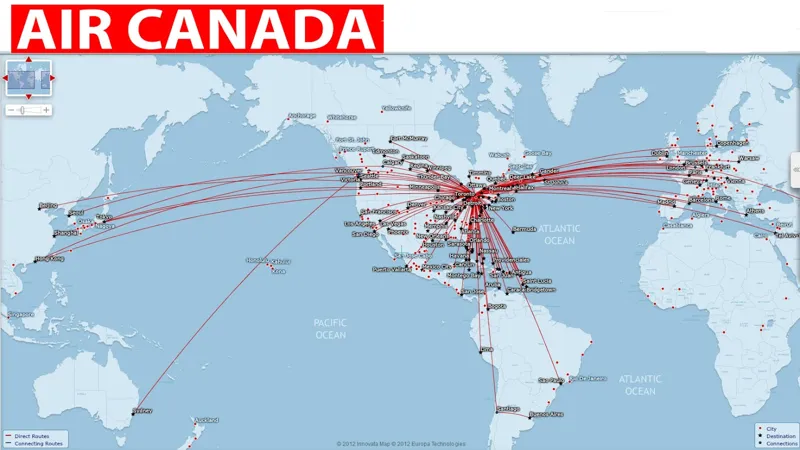Air Canada is gearing up for a significant expansion in the U.S. market, with plans to add up to 15 new destinations over the next three years. This strategic initiative aims to enhance connectivity for American travelers en route to Europe and Asia through Air Canada’s major hubs. As the airline looks to bolster its presence across the U.S., it seeks to increase its airport network from 50 to a target of 60 to 65 locations by 2028. With a robust aircraft order book and a focus on underserved midsize cities, Air Canada’s ambitious plans signal a transformative phase for the airline as it redefines its American connectivity.
| Category | Details |
|---|---|
| Expansion Plans | Add up to 15 new U.S. destinations by 2028. |
| Current U.S. Destinations | 50 U.S. destinations planned for the second quarter of this year. |
| New Destinations | Jacksonville International Airport (JAX) announced as a new destination. |
| Connectivity Focus | Aim to offer more connectivity and expand routes through hubs in Montreal, Toronto, and Vancouver. |
| Targeted Markets | Focus on midsize American cities for better connections to Europe and Asia. |
| Future International Destinations | Plans to include MNL (Philippines), NAP (Italy), PRG (Czech Republic), and OPO (Portugal) by 2025. |
| Aircraft Orders | 83 aircraft on firm order including A220, A321XLR, and Boeing 787-10. |
| Annual Growth | Schedule growth of 5% to 6% annually planned for next 3-4 years. |
| Potential New Destinations | Considering markets like Salt Lake City, San Antonio, and Louisville. |
| Joint Ventures | Collaboration with United Airlines and Lufthansa Group for better route coordination. |
| Traffic Drivers | Major markets like San Francisco, LAX, Chicago, and New York drive most traffic. |
Air Canada’s Ambitious Expansion Plans
Air Canada has exciting plans to expand its reach in the U.S., aiming to add up to 15 new destinations over the next three years. This move is designed to attract more American travelers who fly through Canada on their way to Europe and Asia. The airline hopes to operate at 60 to 65 U.S. airports by 2028, including major hubs like New York’s JFK and LGA. This strategic expansion reflects Air Canada’s commitment to enhancing connectivity for international travelers.
According to Alexandre Lefèvre, Air Canada’s vice president, the airline is focusing on connecting midsize American cities with its main hubs in Montreal, Toronto, and Vancouver. By increasing the number of destinations, Air Canada aims to create more travel options and value for passengers. The airline’s growth strategy is essential as they adapt to changing travel demands and work to improve their service offerings across North America.
Connecting the Dots: Sixth-Freedom Itineraries
Air Canada’s expansion also includes a focus on what is known as ‘sixth-freedom’ itineraries. These routes allow travelers to fly from one country to another with a connection in a third country, which is beneficial for trips to Asia and Europe. By adding more U.S. destinations, Air Canada can offer a wider range of options for travelers looking to connect through its Canadian hubs.
This sixth-freedom strategy is particularly important for Air Canada’s growth in Europe and Asia. With planned new routes to destinations like Naples in Italy and Porto in Portugal, the airline is positioning itself to better serve international travelers. This approach not only increases the number of options for passengers but also enhances the airline’s competitive edge in the global market.
A Robust Fleet for Future Growth
To support its ambitious expansion plans, Air Canada has a solid aircraft order book. With at least 83 new planes on order, including Airbus and Boeing models, the airline is preparing to increase its flight schedule by 5% to 6% annually over the next few years. This investment in new aircraft is crucial for the airline to meet growing travel demand and enhance passenger experience.
However, delivery delays from aircraft manufacturers like Airbus and Boeing pose challenges to Air Canada’s growth. Despite these setbacks, the airline remains optimistic about its ability to expand its network and improve connectivity across North America and beyond. By strategically deploying its new aircraft, Air Canada aims to serve more travelers and strengthen its position in the aviation market.
Identifying Future Destinations
When it comes to choosing new destinations, Air Canada is looking at markets where they can make a significant impact. Places like Oklahoma City and Salt Lake City are on their radar, as these cities have potential for increased travel to Europe. By analyzing travel patterns, Air Canada can identify where their services would be most beneficial for passengers.
Lefèvre, Air Canada’s vice president, emphasized the importance of focusing on markets where they can succeed. They recently ended service to Hartford, but are now considering other routes that align better with their growth strategy. This careful selection process will help Air Canada maximize its resources and provide valuable connections for travelers.
The Importance of Major Markets
While Air Canada is expanding to new destinations, major markets still play a crucial role in their operations. Cities like San Francisco, Los Angeles, Chicago, and New York continue to drive significant traffic for the airline. These key markets often lack enough nonstop flights to meet passenger demand, which presents an opportunity for Air Canada to fill the gap.
As Air Canada looks to grow its U.S. network, maintaining strong connections to these major cities will remain a priority. By ensuring that they provide ample flight options to high-demand destinations, Air Canada can better serve its passengers and enhance its competitive position in the airline industry.
Collaborative Efforts with United Airlines
Air Canada’s expansion strategy is also supported by its joint venture with United Airlines. This partnership allows both airlines to coordinate schedules and fares on routes between the U.S. and Canada, making travel more convenient for passengers. By working together, they can offer better connectivity and more competitive pricing.
The collaboration extends to their joint venture with the Lufthansa Group on transatlantic routes, further enhancing Air Canada’s ability to serve international travelers. This cooperative approach not only benefits the airlines but also provides passengers with seamless travel experiences across multiple destinations, making Air Canada a strong choice for travelers.
Frequently Asked Questions
What is Air Canada’s plan for expanding U.S. destinations?
Air Canada plans to add up to 15 new U.S. destinations over the next three years, aiming to serve 60 to 65 airports by 2028.
Why is Air Canada expanding its U.S. routes?
The expansion focuses on increasing connectivity for American travelers heading to Europe and Asia through Air Canada’s hubs.
What are ‘sixth-freedom’ itineraries?
Sixth-freedom itineraries allow travelers to fly from one country, change planes in another, and reach a third country, enhancing travel options.
Which new U.S. destination has Air Canada announced recently?
Air Canada has announced Jacksonville International Airport (JAX) as its new U.S. destination this year.
How many aircraft does Air Canada have on order?
Air Canada has at least 83 aircraft on firm order, including Airbus and Boeing models, with deliveries scheduled through 2029.
What cities is Air Canada considering for new routes?
Air Canada is looking at midsize cities like Oklahoma City, Salt Lake City, San Antonio, and Louisville for potential new routes.
What joint ventures support Air Canada’s U.S. expansion?
Air Canada collaborates with United Airlines and the Lufthansa Group to coordinate schedules and fares for transborder and transatlantic routes.
Summary
Air Canada is planning to expand its U.S. destinations by adding up to 15 new airports over the next three years, aiming for a total of 60 to 65 locations by 2028. The airline’s strategy focuses on connecting midsize American cities to its hubs in Montreal, Toronto, and Vancouver, facilitating travel to Europe and Asia. Recently, Air Canada introduced Jacksonville International Airport as a new destination. With a robust order of 83 new aircraft, the airline plans to grow its schedule by 5-6% annually, despite potential delivery delays. Major markets like New York and Chicago will continue to be key for Air Canada’s international traffic.



